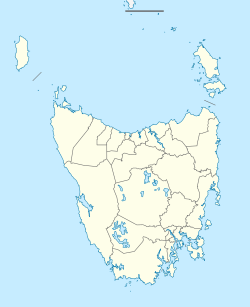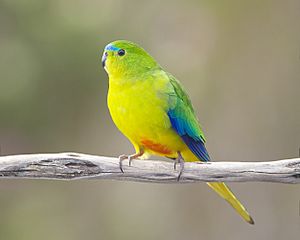Hunter Island (Tasmania) facts for kids
|
Location of the Hunter Island in Bass Strait
|
|
| Geography | |
|---|---|
| Location | Bass Strait |
| Coordinates | 40°30′S 144°47′E / 40.500°S 144.783°E |
| Archipelago | Hunter Island Group |
| Area | 7,330 ha (18,100 acres) |
| Length | 25 km (15.5 mi) |
| Width | 6.5 km (4.04 mi) |
| Administration | |
| State | Tasmania |
Hunter Island is a cool island in Australia. It's the biggest island in the Hunter Island Group. You can find it in the Bass Strait, which is the water between King Island and the northwest part of Tasmania. The island is about 7,330-hectare (18,100-acre) in size.
Hunter Island is located just a few kilometers off the coast of Tasmania. It's close to another island called Three Hummock Island. Today, the island is used as a cattle farm. There's even a house where people live. A special private boat, called a barge, helps transport things to and from Smithton on Tasmania's north coast. The island is about 25 kilometres (16 mi) long and 6.5 kilometres (4.0 mi) wide at its widest point.
Long ago, in 1821, a ship named the Phatisalam was wrecked on Hunter Island.
Hunter Island Group: A Cluster of Islands
Hunter Island is the main island in a group of islands. This group is called the Hunter Island Group. It includes several other smaller islands and rocks.
- Hunter Island
- Albatross Island
- Bears Island
- Bird Island
- Black Pyramid Rock
- Dugay Islet
- Edwards Islet
- Nares Rocks
- Penguin Islet
- South Black Rock
- Steep Island
- Stack Island
- Three Hummock Island
Birds: A Special Stop for Parrots
Hunter Island is a very important place for birds. It's part of something called the Hunter Island Group Important Bird Area. This means it's a protected area where birds can live and travel safely.
One special bird that uses Hunter Island is the orange-bellied parrot. This parrot is very rare and is considered critically endangered. This means there are very few of them left in the world. Hunter Island is on their migration route. They fly over the island when they travel between their breeding grounds in southwest Tasmania and their winter homes in mainland southeastern Australia.



